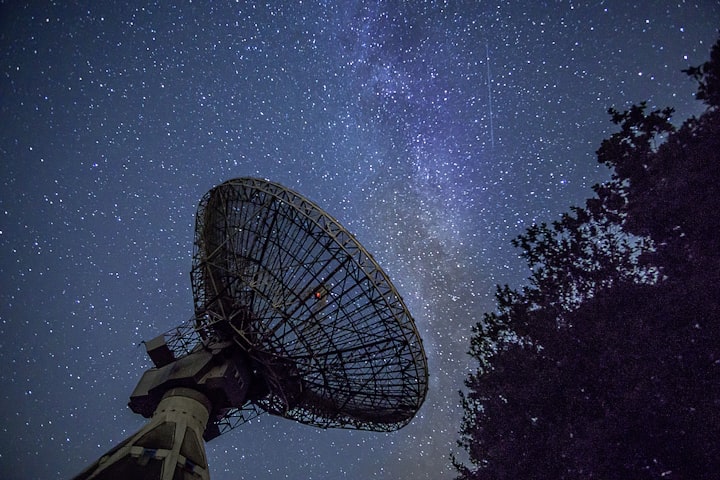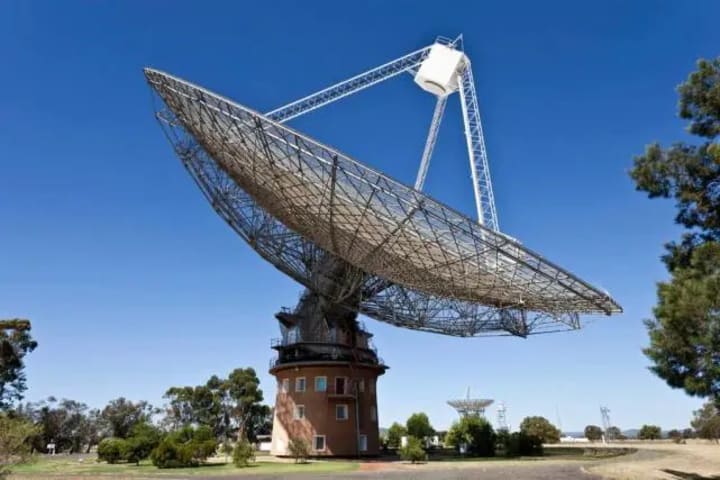Embarrassed or not? The alien signal that scientists have been tracking for 17 years came from a microwave oven on Earth
The biggest oops in the history of astronomy

Astronomers worked hard on a signal for 17 years, with hundreds of papers published, only to discover that it was a signal from a microwave oven!
This is the biggest oops in the history of astronomy, misleading almost a generation of people.
The funniest thing is that one astronomer had his paper all written and not yet published, only to have it announced that it was a misunderstanding.
Countless sweat and hard work all went down the drain in the end. Perhaps this is astronomy, no one knows what will happen tomorrow.
A heartwarming signal
Let's travel back in time to 1998, when the Parkes radio telescope in Australia discovered a new signal, a somewhat mysterious signal, first at high frequency, then gradually decreasing in frequency, and finally settling down.
PARKES telescope (PARKES) is the world's first batch of radio telescopes, built in 1963, and was involved in the Apollo program, and people watched it live on TV back then, there is a role for PARKES in it.
The telescope is located in Australia, which is also known as the mecca of astronomical observation, because the Australian continent is surrounded by the sea on all sides, and it is the only huge piece of land in the whole South Pacific region, Australia is vast and sparsely populated, so it is subject to much less signal interference than other continents.

Australia is in the southern hemisphere, and it can observe a different range of space than the northern hemisphere, which greatly broadens the field of view for human detection.
Astronomers are paying very high attention to this signal as they try to solve the mystery of this mysterious electromagnetic wave.
Astronomers have their own opinions about this signal, some think it is a lightning-triggered pulse, while others think it is an alien signal.
Just as everyone was arguing, the signal reappeared, still with the same recipe and the same frequency, and after a few seconds, the electromagnetic wave on the monitor returned to a straight line.
In the days that followed, this signal appeared intermittently, each time during daylight hours and close to people's meal times.
The Parkes telescope crew had developed a habit of waiting for the signal to arrive with their meals, which became their next meal program during the 17 years of observing.
From 1998 to 2015, rain or shine.
Astronomers wrote hundreds of papers for this signal, published in prestigious journals, and they even gave the signal a namepythonsons (perythons), which is the observation also observed the feelings.
Perythons are very mysterious, astronomers have modeled them a lot, but are unable to simulate the emission source, so it is impossible to confirm which kind of celestial body issued, and do not exclude aliens.
However, in 2015, an event changed the whole dynamic of the study.
The great microwave oops
In 2015, a new colleague discovered that the frequency of this signal was around 2.4 GHz, and isn't this frequency that of a microwave oven? Does this alien also use microwave ovens?
So he set his eyes on the microwave ovens throughout the astronomy station, and he ran to turn them on one by one and had them monitored.
It turned out that the signal came from a microwave oven in one of the research rooms of the observatory, and it did not produce a signal every time it was used.
They experimented hundreds of times, microwave ovens are almost rotten, and finally found the secret of the signal.
It turns out that only when this microwave oven works forcibly opens its door, it will produce this signal.
The reason why it is not detected every day is that some colleagues always wait until the heating is complete before opening the door, which does not generate a signal, only when the microwave oven is forcibly terminated.
This signal can be detected thanks to a colleague in the research laboratory who does not follow the microwave oven instructions and takes out the food every time without finishing heating.
If this old microwave oven is forcibly disconnected, the microwave transmitter inside will leak some microwaves out, it is only 5 meters straight line distance from the signal receiver, so the astronomers can detect so clearly.

Interestingly, this microwave oven used for 17 years is not broken, the results were verified by them to do experiments live broken.
Astronomers face this result is also mixed, on the one hand, they have achieved the results of the study, that is, the source of information is a microwave oven; on the other hand, they have worked for 17 years for this, and this 17 years of effort is now all back to zero.
But astronomical research is so cruel because it is the hypothesis first, and then to argue, the results of the argument are likely to be the opposite of what was previously thought.
Man-made interference
Why were the electromagnetic waves from the microwave ovens received by the Parkes radio telescope? The reason lies in the fact that radio telescopes are too sensitive.
The radio telescope is not so much a clairvoyant as it is a smooth ear, which specializes in receiving electromagnetic waves of all frequencies and wavelengths it can receive.
At the same time, our life is full of all kinds of electromagnetic waves, there are cell phone signals, WiFi signals, television signals, etc., and these will also be "listened to" by the radio telescope.
However, the frequencies of these electromagnetic waves are known, so it is necessary to clean up the signals received by the radio telescope every day to screen out artificial signals.

Take the world's largest FAST radio telescope as an example, it receives tens of thousands of signals every day, and then there are also tens of thousands of human interference, which is equivalent to being enveloped every day by the electromagnetic waves that already exist on Earth.
Sometimes a day down, there is no one is available, astronomers do so day after day, year after year to screen, and extract the useful signal.
Then some people will say that this is because the "listening signal" is too sensitive, we use optical telescopes will not have this effect.
This is not necessarily the case, sometimes seeing may not be true.
In 2017, the Keck Telescope in Hawaii discovered the Big Bang of GN-z11, a galaxy 13 billion light-years away from us, where the Earth was not even born when the Big Bang occurred.
This is the oldest gamma-ray burst ever observed by humans and is as significant as the discovery of aliens.
Scientists are also in full swing, with various published papers, some of which were published in two journals, Nature and Science.
Professor Charles Steinhardt then discovered that the explosion may not have existed in the universe, but was a reflection of sunlight from an object orbiting the Earth.
This discovery shocked the astronomical community at that time, and after careful comparison, people found that the so-called GN-z11 Big Bang was a misunderstanding caused by a piece of space junk, the same as the Peridon signal back then.
As human activities become more and more frequent, telescopes on Earth are facing more and more interference, so how to reduce human interference has become a difficult problem to be solved in astronomical observations.
Away from people
Scientists believe that by placing telescopes outside the Earth, they can effectively avoid all kinds of human interference, and indeed, they do.
The Hubble and Webb space telescopes were launched into space using rockets and placed as far away from Earth as possible so that they would not be disturbed by space junk around Earth.
These two telescopes have indeed lived up to expectations, successfully sending back valuable photographs that have provided important information for studying the universe.
However, space telescopes are limited to optical telescopes, and radio telescopes remain on Earth for their missions.
NASA once planned to build a radio telescope on the moon so that it could exclude human electromagnetic interference and receive a purer sound of the universe, only this intention was not followed with the end of the Apollo program.
The discovery of human technology has reached a point where it interferes with itself, and our planet has been in a noisy environment, and a large part of this "noise" is generated by humans themselves.
How to find a tranquil environment to observe the universe amid this chaos requires continued efforts.
Perhaps somewhere in the universe, an advanced civilization is observing the Earth, and they too think that humans are too noisy!
About the Creator
Richard Shurwood
If you wish to succeed, you should use persistence as your good friend, experience as your reference, prudence as your brother and hope as your sentry.
Reader insights
Outstanding
Excellent work. Looking forward to reading more!
Top insight
Eye opening
Niche topic & fresh perspectives






Comments (1)
Very interesting